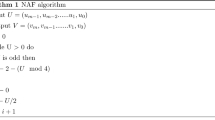Abstract
Linear chirps, a special case of polynomial phase exponentials, have recently been proposed for digital watermarking. In this work, we propose a known-host-state methodology for designing image watermarks that are robust to compression. We use a two-dimensional frequency-modulated chirp as a spreading function in a block-based spatial watermarking scheme. In each block, the chirp is used to embed binary phase information. Chirp parameters allow for spectral shaping of the watermark to match host content. Since host state is known to the embedder, it is possible to tune the chirp for optimum performance, particularly against compression. In contrast to existing chirp watermarking where only a single watermark is generally embedded, the proposed block chirp watermarking allows for a much higher payload. Detection is done using chirp transform subject to key exchange for security. We show that the proposed method significantly outperforms non-adaptive watermarking across all compression factors under variety of attacks.
Similar content being viewed by others
References
Langelaar G.C., Setyawan I., Lagendijk R.L.: Watermarking digital image and video data. IEEE Signal Processing Mag. 17(5), 20–46 (2000)
Kayshan A.S.: Representation and analysis of complex chirp signals. Signal Processing 66, 111–116 (1998)
Chen V.C., Liang H.: Time–Frequency Transforms for Radar Imaging and Signal Analysis. Artech House, London (2002)
Stanković S., Djurović I., Pitas I.: Watermarking in the space/spatial-frequency domain using two-dimensionall Radon–Wigner distribution. IEEE Trans. Image Processing 10, 650–658 (2001)
Mobasseri, B.G.: Digital watermarking in the joint time– frequency domain. In: Proc. IEEE International Conference on Image Processing, vol. 3, pp. 481–484 (2002)
Mobasseri, B., Zhang, Y., Dogahe, B.M., Amin, M.G.: Designing robust watermarks using polynomial phase exponentials. In: IEEE Int. Conf. Acoustics, Speech, and Signal Processing, Philadelphia, PA, March (2005)
Zhang, Y., Dogahe, B.M., Amin, M.G., Mobasseri, B.: Digital watermarking using two-dimensional FM waveforms. In: Advanced Signal Processing Algorithms, Architectures, and Implementations XIV, vol. 5599, pp. 277–288. SPIE (2004)
Aviyente, S., Al-khassaweneh, M.: Robust watermarking in the joint spatial-spectral domain. IEEE Digital Signal Processing Workshop, Taos Ski Valley, NM (2004)
Barkat B., Sattar F.: A new time–frequency based private fragile watermarking scheme for image authentication. IEEE Int. Symp. Signal Processing Appl. 2, 363–366 (2003)
Ramalingam A., Krishnan S.: Robust image watermarking using a chirp detection-based technique. IEE Proc. 152(6), 771–778 (2005)
Hernández J.R., Amado M., Pérez-González F.: DCT-domain watermarking techniques for still images: detector performance analysis and a new Structure. IEEE Trans. Image Processing 9(1), 55–68 (2000)
Erkucuk S., Krishnan S., Zeytinoglu M.: A Robust audio watermark representation based on linear chirps. IEEE Trans. Multimedia 8(5), 925–936 (2006)
Le L., Krishnan S.: Time–frequency signal synthesis and its application in multimedia watermark detection. EURASIP J. Appl. Signal Processing 2006(5), 925–936 (2006)
Kutter M., Winkler S.: A vision-based masking model for spread-spectrum image watermarking. IEEE Trans. Image Processing 11, 16–25 (2002)
Cohen L.: Time–Frequency Analysis. Prentice Hall, Upper Saddle River (1995)
Papandreou-Suppappola A.: Applications in Time–Frequency Signal Processing. CRC Press, Boca Raton (2003)
Shen H., Machineni S., Gupta C., Papandreou-Suppappola A.: Time-varying multichirp rate modulation for multiple access systems. IEEE Signal Processing Lett. 11(5), 497–500 (2004)
Avcibas I., Memon N., Sankur B.: Steganalysis using image quality metrics. IEEE Trans. Image Processing 12(2), 221–229 (2003)
Sheikh H., Bovik A.: Image information and visual quality. IEEE Trans. Image Processing 15(2), 430–444 (2006)
Ebrahimi F., Chamik M., Winkler S.: JPEG vs. JPEG 2000: an objective comparison of image encoding quality. Proc. SPIE Appl. Digital Image Processing XXVII 5558, 303–308 (2004)
Watson, A.B.: Visula optimization of DCT quantization matrices for individual images. In: Proc. AIAA Computing in Aerospace, vol. 9, pp. 286–291, San Diego, CA (1993)
Fleming, C.E., Mobasseri, B.G.: Compression and rotation resistant watermark using a circular chirp structure. In: Proc. SPIE Conference Security, Steganography, and Watermarking of Multimedia Contents VIII, San Jose, CA, Jan. (2006)
Author information
Authors and Affiliations
Corresponding author
Additional information
This work was supported by ONR under Grant No. N00014-04-1-0630. Parts of this work were presented at SPIE Annual Conference, Denver, CO, August 2004, and IEEE International Conference on Acoustics, Speech, and Signal Processing, Philadelphia, PA, March 2005.
Rights and permissions
About this article
Cite this article
Zhang, Y., Mobasseri, B.G., Dogahe, B.M. et al. Image-adaptive watermarking using 2D chirps. SIViP 4, 105–121 (2010). https://doi.org/10.1007/s11760-008-0102-3
Received:
Revised:
Accepted:
Published:
Issue Date:
DOI: https://doi.org/10.1007/s11760-008-0102-3




